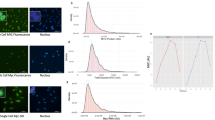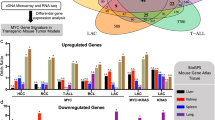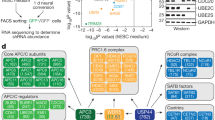Abstract
Members of the Myc proto-oncogene family encode transcription factors that function in multiple aspects of cell behavior, including proliferation, differentiation, transformation and apoptosis. Recent studies have shown that MYC activities are modulated by a network of nuclear bHLH-Zip proteins. The MAX protein is at the center of this network in that it associates with MYC as well as with the family of MAD proteins: MAD1, MXI1, MAD3 and MAD4. Whereas MYC–MAX complexes activate transcription, MAD–MAX complexes repress transcription through identical E-box binding sites. MAD proteins therefore act as antagonists of MYC. Here we report the expression patterns of the Mad gene family in the adult and developing mouse. High level of Mad gene expression in the adult is limited to tissues that display constant renewal of differentiated cell populations. In embryos, Mad transcripts are widely distributed with expression peaking during organogenesis at the onset of differentiation. A detailed analysis of their pattern of expression during chrondrocyte and neuronal differentiation in vivo, and during neuronal differentiation of P19 cells in vitro, shows that Mad family genes are sequentially induced. Mad3 transcripts and proteins are detected in proliferating cells prior to differentiation. Mxi1 and Mad4 transcripts are most abundant in cells that have further advanced along the differentiation pathway, whereas Mad1 is primarily expressed late in differentiation. Taken together, our data suggest that the different members of the MAD protein family exert their functions at distinct steps during the transition between proliferation and differentiation.
This is a preview of subscription content, access via your institution
Access options
Subscribe to this journal
Receive 50 print issues and online access
$259.00 per year
only $5.18 per issue
Buy this article
- Purchase on Springer Link
- Instant access to full article PDF
Prices may be subject to local taxes which are calculated during checkout
Similar content being viewed by others
Author information
Authors and Affiliations
Rights and permissions
About this article
Cite this article
Quéva, C., Hurlin, P., Foley, K. et al. Sequential expression of the MAD family of transcriptional repressors during differentiation and development. Oncogene 16, 967–977 (1998). https://doi.org/10.1038/sj.onc.1201611
Received:
Revised:
Accepted:
Published:
Issue Date:
DOI: https://doi.org/10.1038/sj.onc.1201611
Keywords
This article is cited by
-
Oesophageal adenocarcinoma is associated with a deregulation in the MYC/MAX/MAD network
British Journal of Cancer (2008)
-
An inhibitory effect of MAD1 on bladder tumor cellular proliferation in Vivo
Chinese Journal of Clinical Oncology (2006)
-
Mnt transcriptional repressor is functionally regulated during cell cycle progression
Oncogene (2005)
-
Mxi1-SRα: a novel Mxi1 isoform with enhanced transcriptional repression potential
Oncogene (2004)
-
MYCN-mediated regulation of the MRP1 promoter in human neuroblastoma
Oncogene (2004)



